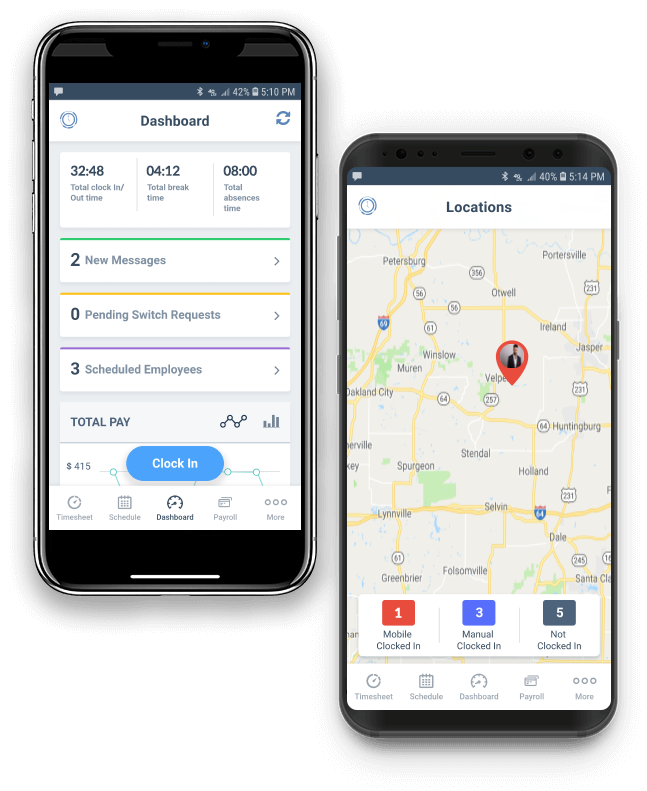
You’ll see that the subscription has cycled. In this case, we’ll set the date to February 1. At this point, no invoice has been generated.Īdvance the date by two weeks. You’ll see a negative proration of -25 USD for the unused time with the ‘basic plan’ and a positive proration of 50 USD for using the ‘premium plan’ for half of the remaining month. Pending invoice items are also created for the prorations.
#FAKE TIME CLOCK APP UPDATE#
Click Update subscription in the top right corner to apply the changes.Īfter upgrading the subscription, the webhook event is created.From the customer account page or the subscription details page, click the overflow menu ( ) associated with a subscription, then select Update subscription.
#FAKE TIME CLOCK APP UPGRADE#
To upgrade a subscription using the Dashboard:

One product is 50 USD/month (‘basic plan’) and the other is 100 USD/month (‘premium plan’). Next, you can test prorations for customers who upgrade their plans in the middle of a billing cycle. By default, the invoice appears in a draft state for one hour.Īdvance the time by one hour to see that the invoice is finalized and paid automatically.įirst, follow these steps to start using test clocks: In doing so, the invoice of 50 USD is paid automatically and the subscription is active.Īdvance the date to February 1 to see that an invoice of 50 USD is created. In the Dashboard, the icon indicates that an object is associated with a clock.Īfter adding a payment method for the customer, create a subscription for the new customer set at 50 USD/month. Learn more about all of the options for creating subscriptions in Subscriptions.īoth the customer and subscription objects are associated with the clock object you created in the first step. Select Email invoice to the customer to pay manually if you want to invoice your customer in arrears.Ĭlick Start test subscription to start the subscription and billing cycle.Select Automatically charge a payment method on file if you want to charge your customer when the billing cycle starts.Select a recurring product and price in the Pricing section.įor the Subscription schedule, define the start and end date for the subscription and when to start the billing cycle. You can also add the customer to a subscription through the customer page, by clicking Actions > Create subscription. Select or search for your customer from the drop-down menu. Go to the test clocks page and find your test clock.Ĭlick Add > Add subscription. To create a subscription for the customer through the Dashboard: Next, you can create up to three subscriptions or subscription schedules for your customer.
#FAKE TIME CLOCK APP FREE#
For some simulations, like testing free trials, you might not want to collect any billing information up front. You can optionally enter other available properties for the customer, like their name, email, and billing information, but none are required. You can add up to three new customers to each simulation. You can’t choose existing customers during test clock simulations.

Go to the test clocks page and find your test clock.The + symbol declares a relative offset, but to determine the relative offset you would have to perform date maths and subtract the current date/time from the target starting date: offset=$(( $(date -date ' 12:47:00' +%s) - $(date +%s) ))įaketime -exclude-monotonic -f "+$offset" bash -c 'watch -n 0.5 date'įortunately, your particular timestamp format can be parsed correctly without needing advanced formatting, and this will provide the behaviour you want: faketime -exclude-monotonic " 12:47:00" bash -c 'watch -n 0.To create a customer for your simulation through the Dashboard: you've used -f): case /* Specific time, but clock along relative to that starttime */ Looking at the source I notice that this behaviour is only applied when the "advanced timestamp specification format" is active (i.e. Here, the time for watch is at odds with the time reported by date. When using the advanced formatting there is no easy way to declare a shared and self-consistent starting point for all subprocesses: faketime -exclude-monotonic -f 12:47:00" bash -c 'watch -n 0.5 date' Indeed, the symbol declares that all subprocesses should start from this absolute time.

If you use the command you've tried, the clock start time is applied to each and every command executed within the faketime environment.


 0 kommentar(er)
0 kommentar(er)
